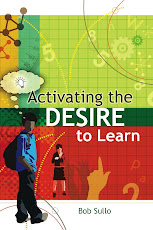An article published by the Huffington Post on July 2, entitled
“In Support of the Whole Child,” looks at the direction of public education. One line in particular caught my attention: “What do we want our children to be like when they are 25?”
For years, I have used some variation of that question with parents, especially when they are having difficulty with their kids” “What do you want your child to be like when he/she is 25?”
While staying in the present moment is generally prudent and helps us live a more intentional life, there are times when we can get trapped by immediate distress. Parents in the middle of a problem – regardless of how “big” or “real” it might be – with their kid, are understandably in a highly emotional state.
Choice theory (internal control psychology) teaches us that behavior has four components (acting, thinking, feelings, physiology) and changing one component necessarily changes the others. Brain-based learning suggests that all behavior is “state dependent:” when we are in the “angry” state, we only have ready access to our angry behaviors; when we are in a “frustrated” state, we only have easy access to our frustrating behaviors, etc. As any parent who has had a crisis with their child knows all too well, it’s really hard to simply “choose to act calmly and wisely” when you are in the middle of it all. Fortunately, there is a solution.
By bumping things into the future – asking yourself “What do I want my kid to be like when he/she is 25?” – you are choosing a new behavior, one less driven by the unproductive frustrating emotion of the present. Your shift in thinking brings an immediate change to your actions, feelings, and physiology. You are literally freed from the shackles of your immediate discomfort when you fast-forward your thinking. You aren’t locked into the realities of the present. Rather than dealing with your whining, belligerent, or insolent present-tense child, you are can image her/him as an adult.
What kind of relationship do you want with this young adult of the future? What do you hope they will be like?
As your brain instantaneously and non-consciously answers these questions and creates your hypothetical child of the future, ask yourself this question: “If this is what I want for my child when she/he is 25, what is the most effective thing I can do right now to help this dream become a reality?”
When you return to the present tense, you’ll find you’ll be less bound by your frustration and more able to generate more effective behaviors to manage the current crisis.
When we are stuck in the “now,” we frequently rely on behaviors driven by the frustration of the moment. By venturing –even for just a few moments – into the future, you access the brain’s creative system and are unencumbered by your immediate concerns.
By the way, I have used the same process with troubled adolescents, asking them, “What kind of relationship do you want to have with your parents when you are 25? Do you want to see them o the holidays? Talk to them on birthdays?” Even the most angry, frustrated, troubled adolescent generally acknowledges that he/she wants a better relationship with their parents when they get older. But locked in the anger of the present, they have little ability to access behaviors that will get them closer to what they want. Helping them imagine a more positive future is a first step in the process.
***
As always, if you enjoyed this and found it useful, please send the link to your friends. Thanks.






No comments:
Post a Comment